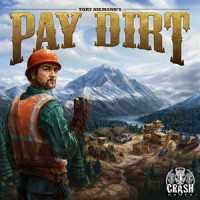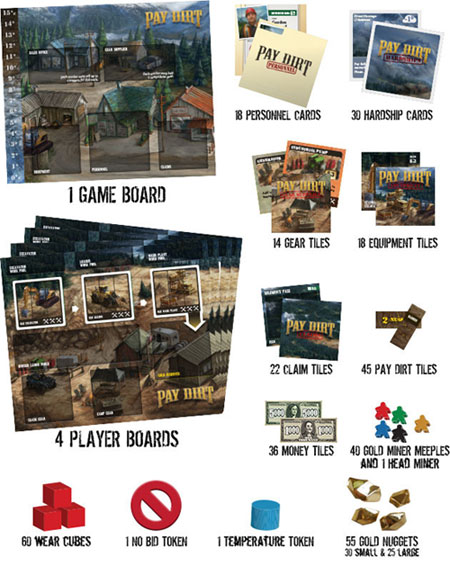
Pay Dirt
Pay Dirt is an engine building, worker placement game set in frigid Alaska for 2-4 players. Players are competing to manage and grow their entire mining outfit while acquiring the most gold before the ground is too frozen to dig. The Alaskan countryside is an inhospitable environment, so players will face hardships that affect their entire outfit – not to mention the ever-dropping temperature that will shut down their operation.

In Pay Dirt, players start with a small basic crew, an unimpressive claim, mediocre equipment and just a little bit of cash to make a go in one of the toughest competitions this side of the globe. Gold mining isn’t cheap and players will have to sell their gold throughout the game to keep the equipment running and their workers happy. Through clever use of their equipment and workers, players can make their mining outfits more efficient and dialed in to their preference of play. Will you recruit heavily and stack your camp with workers or will you keep your eyes on better and more efficient equipment? Will you have what it takes to hit to strike it rich and hit Pay Dirt?
User Reviews (1)
Add a Review for "Pay Dirt"
You must be logged in to add a review.

Overview
Pay Dirt is a game set on the Alaskan frontier. Each player takes on the role of a prospector mining for gold in the frozen north. To add to the excitement of gold mining, the players have made a gentlemen’s wager as to who will have the most gold at the end of the season. During each round, players compete for the limited equipment, land and staff available on the frontier. They use what they have or were able to acquire to try to process pay dirt into gold. If funds run low you can sell your gold to bolster your cash flow, but in the end only the gold matters when the ground freezes and the season ends.
Setup & Play Time
Each player is given a player board representing their mining camp, a greenhorn claim with three barren pay dirt tiles, 5 workers, and $9,000. In the center of the table, the main board and the rest of the materials are placed in the center of the table representing a nearby town where players will compete for mining resources. Set up takes around five to ten minutes.
I have now played this game a half dozen times. The first time took two hours since none of the four players were experienced with the game. The second game with two new players took an hour and a half. The others averaged an hour. So based on these experiences I would say that the hour to hour and a half is an accurate time range for this game with experienced players.
Components
5 Player boards
1 Main Board with a Thermometer
18 Equipment tiles (6 Excavators, 6 Loaders, 6 Wash Plants)
18 Personnel Cards
18 Claim tiles (6 layered Claims, 12 normal Claims, 4 Greenhorn Claim tiles)
14 Gear Tiles
44 Pay Dirt Tiles (20 Barren tiles [worth 2 – 4 nuggets], 12 Promising tiles [worth 3 – 5 nuggets], 12 Rich tiles [worth 4 – 6 nuggets])
30 Hardship Cards
50 Money tokens ($1k [30] and $3k tokens [20])
48 Wear cubes
55 Gold Nuggets (25 small worth 1, 30 large worth 5)
50 Worker meeples (10 each in five colors)
Head Miner token
Auction Token
Temperature token
Instructions / Learning Curve
The rules are laid out logically. It would be nice if there was a player reference sheet, but it is not hard to find what you are looking for.
Game Play
Pay Dirt plays out over a variable number of rounds (between 5 and 15). Each round is comprised of four phases: Auction, Work, Hardship, and Income. Rounds continue until the temperature marker reaches zero or below. When this happens players have one more opportunity to collect as much gold as possible before the ground freezes and a victor is decided.
Auction – In the auction phase a number of items are auctioned off equal to the number of players. The interesting part of this phase is that after the first auction, the category that the purchased item came from (Equipment, Personnel or Claims) becomes closed during the next auction. Get it while it’s hot. By closing part of the auction, you can close off a player from getting access to something that they need. This increases the strategy and fun.
Work – This is the “worker placement” part of the game. Each worker can be assigned to run equipment, repair equipment or gear, and go to town to: visit the supply store or the sales office. There is no restriction on the number of workers that can be assigned to any task so placement is simultaneous. Once all workers are placed, players take turns taking their actions.
Hardship – As an interesting twist, the player in last place (with the least gold) draws hardship cards equal to the number of players then chooses one to suffer, passing the remaining cards to the person in second to last place, etc. Once all the cards are distributed the start player reveals their card, moves the temperature down the indicated amount and suffers the effect of the card. Then each other player suffers the effect of their card (ignoring the temperature).
Income – The final phase of the round allows players to draw money from their cash reserves (normally $2,000). Then the start player marker is passed to the next player the auction and gear areas are refilled and play moves into the next round.
Expansions
As part of the Kickstarter campaign that printed this game three mini expansions were created: Old Timer 1899er, The Last Frontier, & Spectral. Each mini expansion comes with a set of equipment, 1 claim, 1 gear, and 1 personnel. If you get a KS edition they are included in the box. I assume that they will be available at some point to everyone that do not get this version of the game.
Final Thoughts
I have really enjoyed the games of Pay Dirt that I have played and look forward to getting it to the table more. One of my favorite games is Power Grid because I like the auction and tight economics of the game. This game captures a lot of what I love about Power Grid and adds a lot of new twists.
The scarcity of resources, constantly having to send workers to repair equipment and the steady drop in temperature all add to the excitement of the game. I know mining in the Klondike may not appeal to everyone, but I am an experienced miner and have worked in the aggregate and coal mining industries. With a few exceptions, the game represents the mining process very well and brings back fun memories.
I have enjoyed the game play that Pay Dirt has provided; how the auction is broken into three categories with only two of the three available at a time (adding interesting decisions and player interactions). How the gold/victory points are needed to be able to purchase the items you need and how you have to balance your score with your need for cash. Finally, though the players choosing the hardship that they will face makes little sense thematically, it adds tension to the game and creates difficult choices and a balancing act between keeping your operations running and not letting the other players get too far ahead as the temperature quickly drops.
I plan on “blinging” out my copy with tiny pieces of pyrite just to take this already great game up a notch.
Edit: The publisher for this game went out of business in early 2017. It may become hard to find.